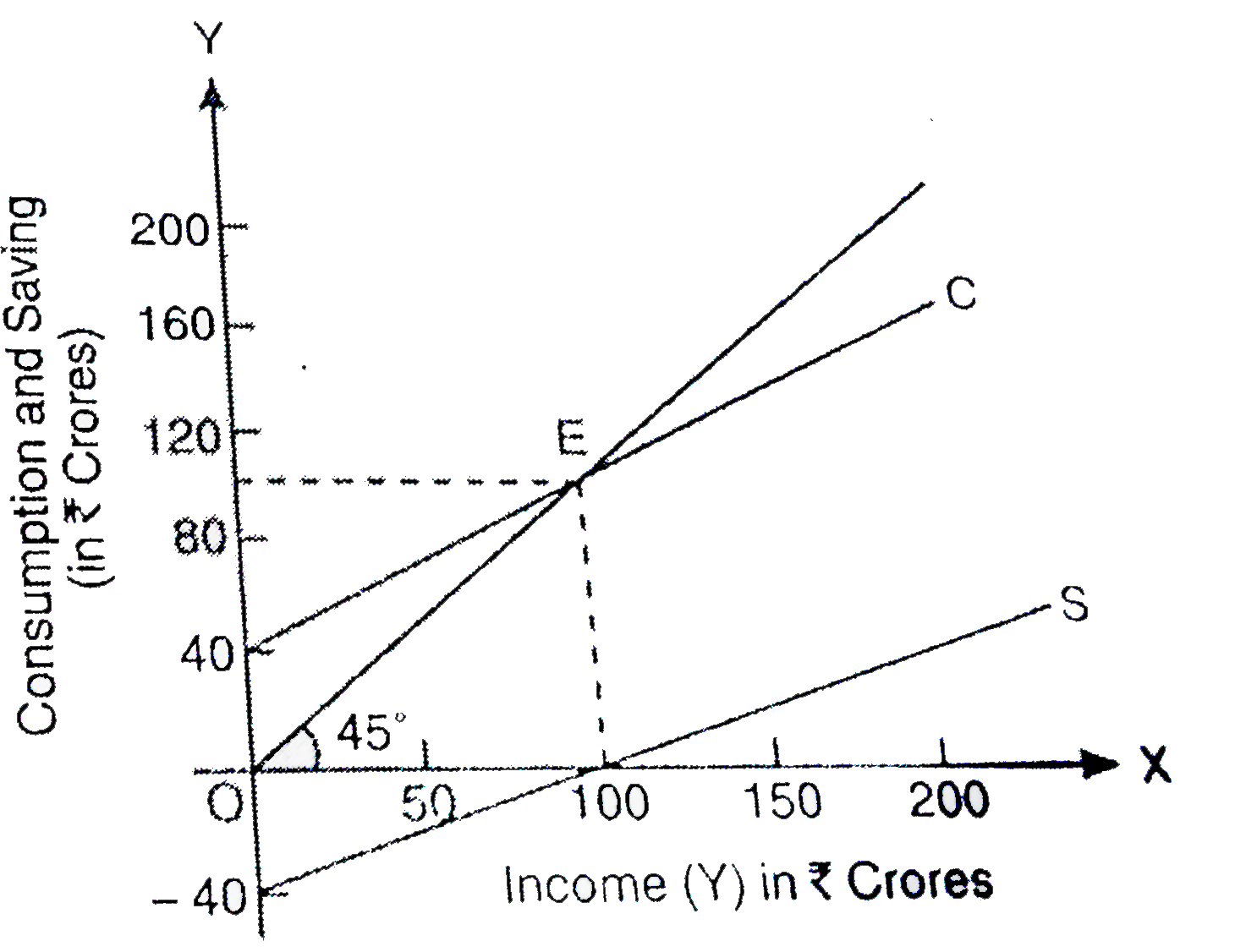Complete Solutions to EXAMPLE of chapter AGGREGATE DEMAND AND RELATED CONCEPTS of Class 12 book with complete answers and questions
| Class 12 | ECONOMICS |
| Chapter | AGGREGATE DEMAND AND RELATED CONCEPTS |
| INTRODUCTORY MACROECONOMICS BY SANDEEP GARG | EXAMPLE |
| Number Of Questions | 33 |
| Academic Year | 2023-24 |
Calculate APC and APS from the following schedule :
`{:(,"Income" (Y),,100,,200,,300),(,"Consumption" (C),,80,,120,,180):}`
View SolutionIf APC of an economy is 0.8, what should be saving at an income level of ₹ 2,000 crores ?
View Solution(i) The disposable income (Y) is ₹ 1200 crores and consumption expenditure ( C) is ₹ 800 crores. Calculate the APC.
If saving is ₹ 500, out of an income of ₹ 5,000, how much is the APS ?
(iii) If disposable income is ₹ 1,000 and consumption expenditure is ₹ 750, find out average propensity to save.
(iv) If income is ₹ 100, calculate APC.
(v) When incomes rises from ₹ 1,000 to ₹ 1,100, saving rise by ₹ 30. Find out MPS and MPC.
View SolutionCalculate MPC from the following schedule:

View SolutionThe level of income, in an economy, increases from ₹ 20,000 crores to ₹ 70,000 crores, and as a result the level of consumption increases from ₹ 15,000 crores to ₹ 45,000 crores. Calculate the MPC.
View SolutionCalculate the value of MPS from the given table:

View SolutionComplete the following table:

View SolutionComplete the following table:

View SolutionComplete the following table:

View SolutionComplete the following table:

View SolutionFrom the following schedule, compute APC, APS, MPC and MPS:

View SolutionGiven that national income is ₹ 80 crore and consumption expenditure ₹ 64 crore, find out average propensity to save. When income rises to ₹ 100 crore and consumption expenditure to ₹ 78 crore, what will be the average propensity to consume and the marginal propensity to consume ?
View SolutionThe consumption expenditure and investment demand are ₹ 600 crores and ₹ 300 crores respectively, when income is ₹ 1,000 crores. Calculate : (i) AD, (ii) AS (iii) Saving.
View SolutionUsing the equation of consumption function: C = `barc` + b(Y), calculate consumption expenditure at the income level of ₹ 500 crores, if autonomous consumption is ₹ 40 crores and 40% of additional income is saved.
View SolutionThe saving curve of an economy makes a negative intercept of ₹ 50 crores and 20 % of additional income is saved. Derive the saving and consumption function.
View SolutionWith the help of saving function: S = -20+ 0.3 (Y), calculate consumption expenditure at the income level of ₹1,000 crores.
View SolutionOn the basis of consumption function: C = 120 + 0.40 Y, answer the following questions:
(i) Derive the saving function.
(ii) Determine the saving at the income level of ₹ 500 crores.
(iii) At what level of income, saving becomes zero ?
View SolutionIf MPC is one-third of MPS and consumption at zero level of national income is ₹ 40 crores, derive the consumption and saving function.
View SolutionThe consumption function for an economy is : C = 20 + 0.8Y (assuming amount in ₹ crores). Determine the level of income when average propensity to consume will be one.
View SolutionThe break-even level of income for an economy is given to be ₹ 10,000 crores. If the economy saves 20 per cent of additional income, then calculate the value of autonomous consumption.
View SolutionGiven below is the consumption function of an economy:
C = 100 + 0.5 Y.
With the help of a numerical example, show that in this economy, as income increases, APC will decrease.
View SolutionIf a consumption function of a hypothetical economy is given as:
C = 100 + 0.6 Y, then
(i) What will be the values of marginal propensity to consume and marginal propensity to save for the economy ?
(ii) Write the corresponding saving function.
View SolutionEstimate the value of Aggregate Demand in an economy if:
`{:(,"(a)","Autonomous Investment (I)",,=100"crores"),(,"(b)","Marginal Propensity to Save",,=0.2),(,"(c)","Level of Income (Y)",,=4","000"crores"),(,"(d)","Autonomous Consumption Expenditure"(barc),,=50"crores"):}`
View SolutionOn the basis of given diagram, answer the following questions:
(i) What is the value of autonomous consumption ?
What is the break-even level of income or at what level of income saving is zero ?
(iii) How much is APC corresponding to point E ?
(iv) If MPC = 0.6, determine the consumption and saving function.

View SolutionThe consumption function of an economy is given as: C= 60+0.6Y. Draw a diagram showing consumption expenditure corresponding to income levels of 0, 100, 200, 300 and 400. (Values of income and autonomous consumption are in ₹ crores).
View SolutionThe consumption function is given as C = 40+0.6Y. Derive saving function.
View SolutionThe consumption function of an economy is given as: C=60+0.6Y. For the given consumption function, calculate the break-even level of income.
View SolutionWhich of the following can have the value of more than one and less than zero: (i) APC, (ii) APS, (iii) MPC, and (iv) MPS ?
View SolutionDraw on a diagram a straight line savings curve for an economy. From it derive the consumption curve, explaining the method of derivation. Show a point on the consumption curve at which average propensity to consume is equal to 1.
View SolutionExplain the relationship between average propensity to consume and average propensity to save. Can the value of average propensity to consume be greater than 1 ? Given reasons for your answer.
View SolutionDistinguish between voluntary unemloyment and involuntary unemployment. What is the significance of this distinction ?
View SolutionDiscuss the significance of `45^(@)` line in Keynesian Economics.
View SolutionWhat is ex-ante consumption ? Distinguish between autonomous consumption and induced consumption.
View Solution
EXAMPLE questions and complete solutions for chapter AGGREGATE DEMAND AND RELATED CONCEPTS of SANDEEP GARG ECONOMICS (HINGLISH) of Class 12